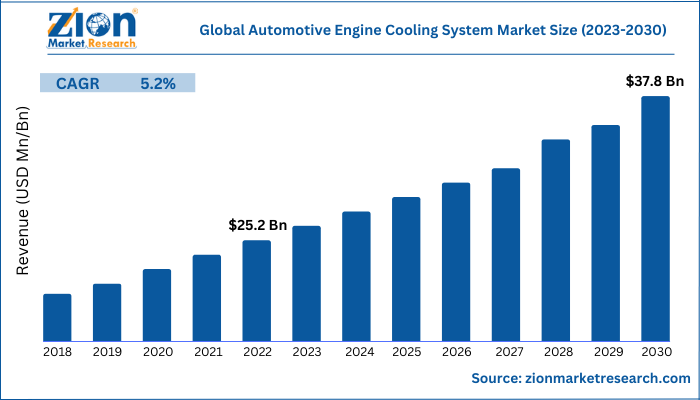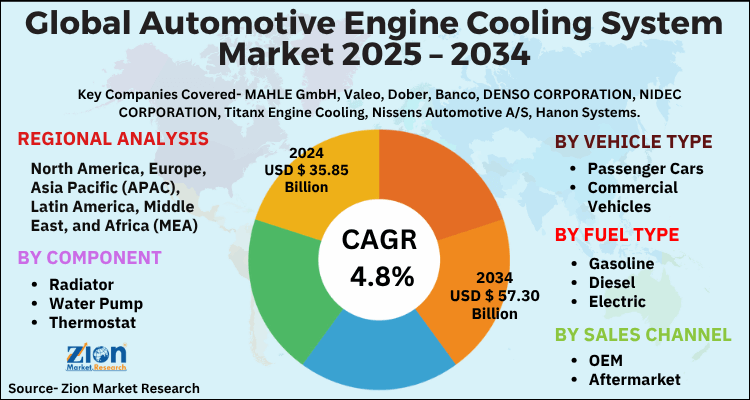Global Automotive Engine Cooling System Market Size, Share, Growth Analysis Report - Forecast 2034

Automotive Engine Cooling System Market By Component (Engine Cooling Module, Reserve Tank, Cooling Fan Control Module, Radiator, Cooling Fan, Cooling Fan Belt, Radiator Hose, Water Pump, Thermostat, and Others), By Vehicle Type (Passenger Vehicles, Light Commercial Vehicles, Heavy Commercial Vehicles, and Electric Vehicles), By Fuel Type (Gasoline, Diesel, Electric), By Sales Channel (OEM, Aftermarket), and By Region: Global and Regional Industry Overview, Market Intelligence, Comprehensive Analysis, Historical Data, and Forecasts 2025 - 2034
| Market Size in 2024 | Market Forecast in 2034 | CAGR (in %) | Base Year |
|---|---|---|---|
| USD 35.85 Billion | USD 57.30 Billion | 4.8% | 2024 |
Automotive Engine Cooling System Market: Industry Perspective
The global automotive engine cooling system market size was worth around USD 35.85 Billion in 2024 and is predicted to grow to around USD 57.30 Billion by 2034 with a compound annual growth rate (CAGR) of roughly 4.8% between 2025 and 2034. The report analyzes the global automotive engine cooling system market's drivers, restraints/challenges, and the effect they have on the demands during the projection period. In addition, the report explores emerging opportunities in the automotive engine cooling system industry.
Automotive Engine Cooling System Market: Overview
The cooling system is made up of several parts that allow liquid coolant to move into the engine block and head's passages and absorb combustion heat. The heated fluid will then be redirected to the condenser for cooling via a rubber hose. An air stream cools the heated fluid (hot water) as it enters the radiator through the small channels.
Modern internal combustion engines use both liquid and air cooling, but some engines also use one or the other to eliminate waste heat. The system is lightweight and comparatively simple because the air from the atmosphere is used to cool special purpose or small engines. While in some motors the cooling is accomplished by transferring heat from a closed water loop to the radiator.
Compared to air, water is better able to transfer heat away from the engine rapidly. The engine becomes heavier, more expensive, and more complicated due to the water cooling system's components. The system works well with more powerful engines that can move more weight but also generate more waste heat.
Key Insights
- As per the analysis shared by our research analyst, the global automotive engine cooling system market is estimated to grow annually at a CAGR of around 4.8% over the forecast period (2025-2034).
- Regarding revenue, the global automotive engine cooling system market size was valued at around USD 35.85 Billion in 2024 and is projected to reach USD 57.30 Billion by 2034.
- The automotive engine cooling system market is projected to grow at a significant rate due to Increasing vehicle production and demand for thermal management in high-performance and electric vehicles drive market growth.
- Based on component, the reserve tank segment is expected to lead the global market.
- On the basis of vehicle type, the passenger vehicles segment is growing at a high rate and will continue to dominate the global market.
- Based on the fuel type, the gasoline segment is projected to swipe the largest market share.
- By sales channel, the OEM segment is expected to dominate the global market.
- Based on region, Asia-Pacific is predicted to dominate the global market during the forecast period.
Automotive Engine Cooling System Market: Growth Drivers
The growing production of vehicles drives the market growth
The market for automobile engine cooling systems is experiencing growth due to an increase in the use of vehicles such as passenger cars, light commercial vehicles (LCVs), and heavy commercial vehicles (HCVs). The production of powerful engines, which produce a lot of heat and need cooling fans, has been steadily increasing in the automotive industry in recent years. Globalization, urbanization, increasing consumer per capita income, a burgeoning population, and changes in middle-class families' lifestyles are some of the key factors that are anticipated to increase demand for automotive engine cooling systems market during the forecast period. Before a significant decline after Covid, production statistics for cars and commercial vehicles increased quickly from 79.8 million in 2011 to 97.3 million in 2019, according to OICA.
Automotive Engine Cooling System Market: Restraints
The high cost of technology impedes the market growth
One of the major things impeding the market for automotive engine cooling systems from expanding is the high cost of the technologies used in their development. Utilizing costly technologies increases the cost of the system, which raises the cost of the vehicle overall and has a negative effect on market demand, particularly in developing countries where customers are often price-sensitive.
Automotive Engine Cooling System Market: Opportunities
Increasing demand for EVs offers an attractive opportunity
Global demand for electric and hybrid vehicles is on the rise, providing an opportunity for the automotive engine cooling system industry to expand over the forecast period through the use of ever-more-advanced parts. Along with government efforts, rising research and development activities in the field of engine cooling systems for cars and other vehicles have opened up opportunities for the global market for these systems to grow. The efficiency of the engine can be improved through electrification, which also reduces CO2 pollution and the consumption of fossil fuels.
Additionally, several county governments have launched programs to boost production and promote the purchase of electric cars. Additionally, it is anticipated that the emphasis on buying electric vehicles by multiple government departments will offer opportunities for the market, which in turn will fuel the expansion of the electric vehicle's engine cooling system market. The need for electric vehicles has increased as a result of falling battery prices and rising battery capacity. This is expected to have a significant effect on the market growth for engine cooling systems for electric vehicles. Additionally, it is expected that technological developments in charging stations will boost demand for electric cars, which will have an effect on the market growth for electric cars' engine cooling systems. In 2021, nearly 6.5 million electric vehicles (EVs) were shipped globally, up 195% from 2019 and up 109% from 2020.
Automotive Engine Cooling System Market: Challenges
Downsizing gasoline and diesel engines poses a major challenge
Automobile original equipment makers (OEMs) are primarily concentrating on downsizing gasoline and diesel engines, making it more difficult for engine cooling system manufacturers to improve their engine cooling modules. Engine downsizing is a procedure that is constantly being improved. Major automotive engine cooling system market players are developing several novel methods to improve power and fuel economy at low engine capacities. For an engine, depending on the combustion process and the level of downsizing, fuel usage reductions of 10% to 30% may be feasible. Even though downsizing reduces a vehicle's top speed, numerous tests point to the existence of an ideal engine displacement. Direct charging, turbocharging, and flexible valve timing are likely to combine to become the norm in the near future. The primary difficulty in the engine cooling system of an automobile is downsizing an engine, which may result in a decline in performance while enhancing other factors.
Automotive Engine Cooling System Market: Segmentation
The global automotive engine cooling system market is segmented based on component, vehicle type, fuel type, sales channel, and region.
Based on the component, the global market is bifurcated into engine cooling module, reserve tank, cooling fan control module, radiator, cooling fan, cooling fan belt, radiator hose, water pump, thermostat, and others. The reserve tank segment is expected to dominate the market over the forecast period. In terms of reliability, efficiency, and safety, the fuel tank in an automobile is crucial. A current meter and a tank-mounted float sensor are connected in series to form the gasoline reserve indicator circuit system. When the tank is empty, the float-driven sensor, which is connected to an internal rheostat, has a high impedance. When the tank is nearly empty, the fuel monitoring circuit senses the voltage variation that has formed across the meter and triggers the indicator. The range of uses for the sensors that beep when the fuel tank is empty is anticipated to expand due to their contribution to lowering engine heat.
Based on the vehicle type, the global automotive engine cooling system industry is segmented into passenger vehicles, light commercial vehicles, heavy commercial vehicles, and electric vehicles. The passenger vehicles segment is expected to capture the largest market share over the forecast period owing to the growing demand for passenger vehicles across the globe. In the upcoming years, it is anticipated that the production of passenger cars will continue to rise, creating substantial opportunities for the market for automotive engine cooling systems. The prevalence of HCVs is expected to rise significantly. Heavy goods like building materials, ore, and other items are typically transported using HCVs. The demand for HCVs is expected to increase due to rising construction projects and investments, which will have an impact on the growth of the automotive engine cooling system market.
By Fuel Type, the global automotive engine cooling system market is split into gasoline, diesel, and electric.
In terms of Sales Channel, the global automotive engine cooling system market is categorized into OEM and Aftermarket.
Automotive Engine Cooling System Market: Report Scope
| Report Attributes | Report Details |
|---|---|
| Report Name | Automotive Engine Cooling System Market |
| Market Size in 2024 | USD 35.85 Billion |
| Market Forecast in 2034 | USD 57.30 Billion |
| Growth Rate | CAGR of 4.8% |
| Number of Pages | 204 |
| Key Companies Covered | MAHLE GmbH, Valeo, Dober, Banco, DENSO CORPORATION, NIDEC CORPORATION, Titanx Engine Cooling, Nissens Automotive A/S, Hanon Systems, MODINE MANUFACTURING COMPANY, Maxgear, AKG Group, SPAL Automotive, Solvay, BorgWarner Inc., Imcomex, Wabtec Corporation, Otsa Otomotiv San.ve Tic.Ltd.Sti., Horton Holding, Inc., Adams Thermal Systems, and Air International Thermal Systems among others., and others. |
| Segments Covered | By Component, By Vehicle Type, By Fuel Type, By Sales Channel, and By Region |
| Regions Covered | North America, Europe, Asia Pacific (APAC), Latin America, The Middle East and Africa (MEA) |
| Base Year | 2024 |
| Historical Year | 2020 to 2023 |
| Forecast Year | 2025 - 2034 |
| Customization Scope | Avail customized purchase options to meet your exact research needs. Request For Customization |
Automotive Engine Cooling System Market: Regional Analysis
The Asia Pacific is expected to dominate the market during the projected period
The Asia Pacific is expected to dominate the global automotive engine cooling system market during the forecast period. The growth in the region is attributed to the rapid growth in the automobile sector, especially in the countries like China and India. For instance, China remains to be the world's largest market for automobiles in terms of both annual sales and manufacturing output. The number of vehicles produced domestically is expected to hit 35 million by 2025. More than 25 million vehicles, including 19.99 million passenger cars, were delivered in 2020, the Ministry of Industry and Information Technology reports, a 6.5% decline from 2019.
Commercial vehicle sales rose from 2019 to 5.23 million units, a 20% increase. Moreover, the market in Asia-Pacific is expected to grow during the forecast period due to the region's accessibility to cheap labor and raw materials as well as the rising number of local producers. India is currently the second-largest commercial vehicle developer and the sixth-largest passenger vehicle developer in the world. Infrastructure upgrades have substituted rapid urbanization, which is likely to be advantageous for the development of the local market. Demand for light passenger cars and heavy-duty lorries has increased due to the growth of small and medium-sized businesses. Furthermore, the increasing population base along with the growing disposable income drives the demand for vehicles, in turn, propelling the growth of the automotive engine cooling system market in the region.
Europe is expected to hold a significant market share during the forecast period. The growth in the region is attributed to the presence of major players such as MAHLE GmbH and others. Moreover, the growing automotive industry is one of the key factors that propel the automotive engine cooling system market over the forecast period. For instance, according to the ACEA, New petrol car registrations in the EU increased by 11.1% in February 2023, maintaining a market share of 36.9%, matching the share seen in 2022. This increase was attributed to Spain (+19.0%), Italy (+16.3%), Germany (+8.9%), and France (+7.7%). Furthermore, the increasing government initiatives are expected to flourish the market expansion over the projected period.
Recent Developments:
- In August 2022, the global lubricant maker Valvoline Cummins unveiled Valvoline Advanced Coolant, a glycol-based full-antifreeze coolant for cars and commercial vehicles. According to the manufacturer, the product includes OAT technology, which offers a drain period of up to 5,000 kilometers (5 years) of service life. Additionally, this new coolant is backward compatible with every cooling system that uses OAT coolants, offering protection in extremely hot and cold climates, protecting engines from overheating, and keeping them operating in freezing weather.
- In September 2021, to charge electric vehicles more quickly, MAHLE created a new battery cooling system. The maximum temperature of the battery is ensured to significantly decrease during charging and the average temperature is distributed in a much more uniform manner by an electrically nonconductive coolant flowing around the cells.
- In May 2022, Freecor® EV Milli 10 was introduced as a novel coolant by Arteco. For indirect cooling of battery electric vehicles, Freecor® EV Milli 10 is a decreased electrical conductivity coolant (100 S/cm). This reduced electrical conductivity coolant provides all-around corrosion protection and was created using the tested Organic Additive Technology (OAT). Freecor® EV Milli 10's unique combination of inhibitors and stabilizers guarantees that the cooling system's electrical conductivity will remain low and stable over time. The brazing flux compensation package in Freecor® EV Milli 10 makes it the first coolant of its kind to account for aluminum CAB brazing flux, enhancing the coolant's compatibility with components made in this manner.
- In April 2021, to provide the rapidly expanding electric vehicle (EV) market with unheard-of power and safety, XING Mobility and Castrol announced a collaboration to advance XING Mobility's immersion cooling battery technology.
Automotive Engine Cooling System Market: Competitive Analysis
The report provides a company market share analysis to give a broader overview of the key market players. In addition, the report also covers key strategic developments of the market, including acquisitions & mergers, new product launches, agreements, partnerships, collaborations & joint ventures, research & development, and regional expansion of major participants involved in the automotive engine cooling system market on a global and regional basis.
The global automotive engine cooling system market is dominated by players like:
- MAHLE GmbH
- Valeo
- Dober
- Banco
- DENSO CORPORATION
- NIDEC CORPORATION
- Titanx Engine Cooling
- Nissens Automotive A/S
- Hanon Systems
- MODINE MANUFACTURING COMPANY
- Maxgear
- AKG Group
- SPAL Automotive
- Solvay
- BorgWarner Inc.
- Imcomex
- Wabtec Corporation
- Otsa Otomotiv San.ve Tic.Ltd.Sti.
- Horton Holding Inc.
- Adams Thermal Systems
- Air International Thermal Systems
The global automotive engine cooling system market is segmented as follows:
By Component
- Engine Cooling Module
- Reserve Tank
- Cooling Fan Control Module
- Radiator
- Cooling Fan
- Cooling Fan Belt
- Radiator Hose
- Water Pump
- Thermostat
- Others
By Vehicle Type
- Passenger Vehicles
- Light Commercial Vehicles
- Heavy Commercial Vehicles
- Electric Vehicles
By Fuel Type
- Gasoline
- Diesel
- Electric
By Sales Channel
- OEM
- Aftermarket
By Region
- North America
- The U.S.
- Canada
- Europe
- France
- The UK
- Spain
- Germany
- Italy
- Rest of Europe
- Asia Pacific
- China
- Japan
- India
- South Korea
- Southeast Asia
- Rest of Asia Pacific
- Latin America
- Brazil
- Mexico
- Rest of Latin America
- Middle East & Africa
- GCC
- South Africa
- Rest of Middle East & Africa
Table Of Content
Methodology
FrequentlyAsked Questions
The cooling system is made up of several parts that allow liquid coolant to move into the engine block and head's passages and absorb combustion heat.
The global automotive engine cooling system market is expected to grow due to Increasing vehicle production and demand for thermal management in high-performance and electric vehicles drive market growth.
According to a study, the global automotive engine cooling system market size was worth around USD 35.85 Billion in 2024 and is expected to reach USD 57.30 Billion by 2034.
The global automotive engine cooling system market is expected to grow at a CAGR of 4.8% during the forecast period.
Asia-Pacific is expected to dominate the automotive engine cooling system market over the forecast period.
Leading players in the global automotive engine cooling system market include MAHLE GmbH, Valeo, Dober, Banco, DENSO CORPORATION, NIDEC CORPORATION, Titanx Engine Cooling, Nissens Automotive A/S, Hanon Systems, MODINE MANUFACTURING COMPANY, Maxgear, AKG Group, SPAL Automotive, Solvay, BorgWarner Inc., Imcomex, Wabtec Corporation, Otsa Otomotiv San.ve Tic.Ltd.Sti., Horton Holding, Inc., Adams Thermal Systems, and Air International Thermal Systems among others., among others.
The report explores crucial aspects of the automotive engine cooling system market, including a detailed discussion of existing growth factors and restraints, while also examining future growth opportunities and challenges that impact the market.
HappyClients
Zion Market Research
Tel: +1 (302) 444-0166
USA/Canada Toll Free No.+1 (855) 465-4651
3rd Floor,
Mrunal Paradise, Opp Maharaja Hotel,
Pimple Gurav, Pune 411061,
Maharashtra, India
Phone No +91 7768 006 007, +91 7768 006 008
US OFFICE NO +1 (302) 444-0166
US/CAN TOLL FREE +1 (855) 465-4651
Email: sales@zionmarketresearch.com
We have secured system to process your transaction.
Our support available to help you 24 hours a day, five days a week.
Monday - Friday: 9AM - 6PM
Saturday - Sunday: Closed







